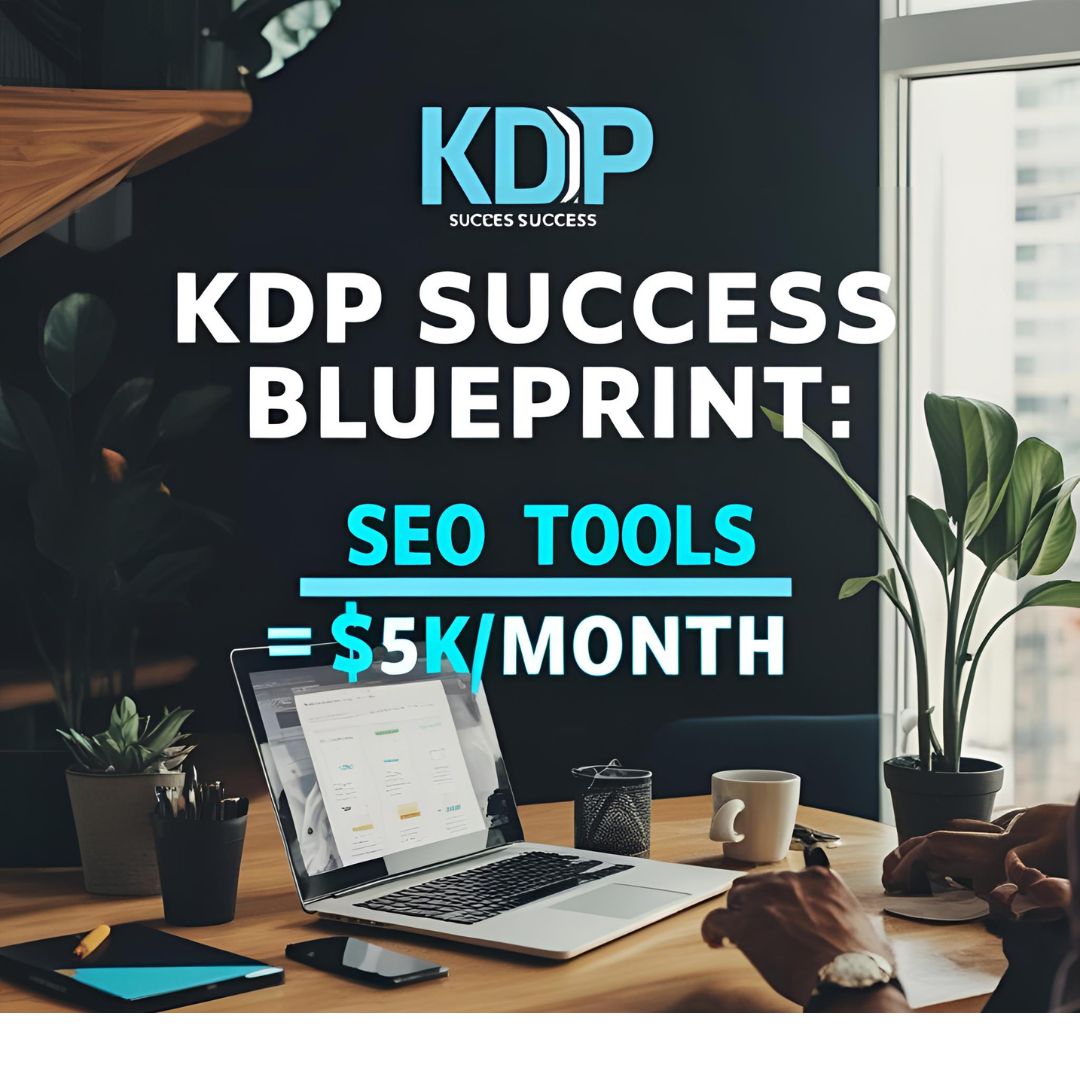Introduction
Kindle Direct Publishing (KDP) has emerged as a powerful platform for authors seeking to self-publish their work and generate income. By providing a user-friendly interface that allows writers to create, publish, and distribute their books globally, KDP opens doors for aspiring authors to turn their literary dreams into a sustainable source of revenue. However, despite the advantages of self-publishing, many authors encounter significant challenges, particularly when it comes to achieving visibility and driving sales in a highly competitive marketplace.
One of the most pressing pain points for KDP authors is the struggle to be seen. As thousands of new titles are released daily, standing out is no easy feat. Effective search engine optimization (SEO) strategies can help authors enhance their visibility and ensure that their books reach the target audience. But for many, the complexities of SEO can be intimidating. Questions arise: Which keywords should be targeted? How can one optimize their book listing without incurring additional costs? Fortunately, there are numerous free tools available that can aid authors in navigating the intricacies of SEO, allowing them to maximize their book’s potential without a hefty investment.
This blog post aims to demystify the process of utilizing these free SEO tools to achieve a monthly income of $5,000 through KDP. Readers will learn practical strategies to enhance their book visibility, explore the nuances of keyword optimization, and understand how to leverage data from these tools effectively. With the right approach and resources, aspiring authors can unlock their potential and set themselves on a path toward financial success in the world of self-publishing.
Understanding KDP and SEO
Kindle Direct Publishing (KDP) has revolutionized the way authors bring their works to market, providing a platform that allows for easy self-publishing of eBooks and paperbacks. With KDP, authors maintain control over their creative output, managing aspects such as pricing, distribution, and marketing strategies. The platform is particularly enticing because it offers a straightforward path to publication, allowing creators to reach a global audience with minimal upfront investment. However, simply publishing a book does not guarantee its success. Herein lies the significance of Search Engine Optimization (SEO).
SEO is a critical element in the self-publishing landscape. It involves optimizing a book’s metadata—titles, subtitles, keywords, and descriptions—to enhance visibility within Amazon’s search engine and, consequently, drive sales. Unlike traditional marketing methods that rely heavily on promotional campaigns and ads, SEO focuses on increasing organic traffic. By strategically using relevant keywords and phrases, authors can position their books in front of potential readers who are actively seeking content in their genre. This is particularly crucial on a platform like Amazon, where millions of titles compete for attention.
The integration of effective SEO strategies can lead to higher rankings in search results, making books more discoverable to audiences. Optimization should not be viewed as a one-time task, but rather an ongoing aspect of an author’s promotional efforts, especially for long-term visibility and sustained sales. Authors equipped with a solid understanding of KDP and SEO can leverage these tools to carve a niche in a crowded marketplace. This agility in marketing differentiates successful self-published authors from those who struggle to gain traction in their respective genres.
Identifying Your Target Audience
Understanding your target audience is crucial for any successful KDP (Kindle Direct Publishing) author. The process begins with defining who your readers are, which can include aspects such as age, gender, interests, and reading habits. Gathering this information enables authors to create tailored content that resonates with readers, increasing the likelihood of engagement and sales.
To effectively identify your target audience, consider utilizing various research techniques. Surveys and questionnaires are a valuable method to gain direct feedback from readers. By asking specific questions about their preferences, such as preferred genres, topics of interest, and reading frequency, authors can gather pertinent data that reflects the audience’s desires. Moreover, analyzing reader reviews on similar books can provide insights into what aspects resonate or repel potential readers. This qualitative data can be instrumental in guiding content creation.
Another effective technique includes exploring social media platforms and online forums. Websites such as Goodreads and Facebook groups related to specific genres can serve as rich resources for understanding reader communities. Observing discussions, top-rated books, and trending topics can help reveal gaps in the market and opportunities for new content that appeals to your audience.
Moreover, leveraging analytics tools can assist in examining reader behaviors. Platforms associated with KDP often provide data on readership patterns and demographic breakdowns. Utilizing these analytics enables authors to fine-tune their approach and ensure that their marketing strategies align with audience preferences.
In conclusion, by thoroughly researching and analyzing reader preferences and behaviors, KDP authors can create content that speaks directly to their target audience. This informed approach not only enhances the quality of the work produced but also increases the potential for greater sales and a loyal readership base.
Keyword Research: The Foundation of SEO
Effective keyword research is paramount for authors seeking success in Kindle Direct Publishing (KDP). It serves as the groundwork for optimizing book visibility, driving sales, and ultimately increasing revenue. By identifying and utilizing the right keywords, authors can significantly enhance their chances of reaching the right audience. This process encompasses not just primary keywords—the main terms that potential readers might use—but also LSI (Latent Semantic Indexing) keywords, which are semantically related phrases that help fine-tune content relevance.
To begin your keyword research, free tools like Google Keyword Planner, Ubersuggest, and Answer the Public offer invaluable insights. These platforms help you discover both high-volume primary keywords as well as LSI keywords, allowing for a comprehensive approach to your title and description. Start with a broad term relevant to your book’s content, and then use these tools to uncover variations and related phrases. This approach not only aids in finding the right terminology but also helps you understand market trends and reader intent, which is critical for maximizing your book’s exposure.
Once you have compiled a list of effective keywords, strategize their placement within your book’s metadata. The title and subtitle are prime real estate for primary keywords, while your book description can be enriched with LSI keywords to provide context and increase relevance. Maintaining a natural flow in your writing is essential; overstuffing these elements with keywords can detract from the reader experience and could lead to being penalized by search algorithms. Additionally, keep in mind that updating your keywords periodically based on sales performance can further enhance your book’s discoverability in the competitive KDP landscape.
Optimizing Your KDP Listings
Optimizing your KDP listings is essential for increasing visibility and driving sales. One of the key components of a successful KDP listing is the book description. A compelling description should not only provide a summary of the book’s content but also entice potential readers by highlighting its unique selling points. When crafting your description, consider using short paragraphs, bullet points, and engaging language that speaks directly to your target audience. Incorporating relevant keywords and phrases naturally can enhance search visibility while ensuring the content remains engaging.
Effective titles play a critical role in optimization as well. A well-crafted title should be catchy yet descriptive, making it easy for readers to understand the essence of the book. Including keywords in the title is beneficial for search engine optimization, but it is crucial to maintain coherence and professionalism. Avoid overloading the title with excessive keywords; instead, focus on clarity and appeal to encourage clicks. Additionally, consider subtitle options that further specify the book’s theme or audience, providing additional opportunities for keyword integration.
Choosing the right categories is another vital aspect of KDP optimization. Select categories that accurately reflect your book’s content and align with readers’ interests. Research popular categories in your niche and consider their competitiveness. Utilize Amazon’s tools to identify the best fit, which can aid in elevating your book’s placement in potential readers’ searches. Combining these elements—compelling descriptions, effective titles, and appropriate categories—creates a strong foundation for your KDP listing, making it more attractive and discoverable for potential readers.
Leveraging Social Media and Online Communities
For KDP authors, harnessing the power of social media and online communities is essential in promoting their books and driving sales. Social media platforms such as Facebook, Twitter, Instagram, and TikTok offer a robust opportunity to connect with potential readers and create a loyal following. Building an effective social media presence begins with identifying the platforms where your target audience spends the most time. Each platform has its unique demographic, allowing authors to tailor their content accordingly.
One effective strategy for successfully engaging with readers is to share relevant content that goes beyond merely promoting your books. Authors can use these platforms to provide insights into their writing process, share behind-the-scenes glimpses, or discuss topics related to their book’s themes. This not only fosters a sense of community but also establishes the author as an authority in their genre. Regular interaction with followers through comments, live sessions, and Q&As can enhance engagement, making readers feel more connected to the author.
In addition to creating a personal brand, authors can leverage online communities such as Goodreads, Reddit, and genre-specific forums to reach a more targeted audience. Join groups that align with your book’s genre and actively participate in discussions. Offering valuable input or sharing expertise without overtly promoting your work can spark interest in your books. Moreover, consider utilizing these platforms for exclusive promotions or giveaways to further entice potential readers.
Another crucial aspect of using social media and online communities effectively is driving traffic to KDP listings. Authors should always include links to their books in their profiles and promote content that leads readers directly to their listings. By combining an authentic approach to engagement with strategic marketing efforts, KDP authors can significantly enhance their visibility and increase their chances of achieving substantial sales.
Using Free SEO Tools to Track Your Progress
In the current digital landscape, tracking the performance of your book is crucial for maximizing its visibility and sales on platforms such as Amazon Kindle Direct Publishing (KDP). Free SEO tools can significantly aid authors in this regard by providing valuable insights into keyword performance, market trends, and sales dynamics. Here, we explore several effective tools that can enhance your understanding of your book’s performance.
One popular tool is Google Analytics, which, although typically associated with websites, can be effectively utilized to monitor traffic directed to your book’s sales page. By setting up UTM parameters on your book’s links, you can track visitors coming from various sources, such as social media or email marketing campaigns. Analyzing this data can help identify which promotional strategies yield the best results.
Another noteworthy tool is Ubersuggest, which allows authors to track keyword performance and offers insights into the competition. You can enter specific keywords related to your book’s genre or themes and receive data on search volume, click-through rates, and SEO difficulty. This information is invaluable for adjusting your keyword strategy and enhancing your book’s ranking in search results.
Additionally, tools like Amazon’s own KDP Reports provide authors with essential sales metrics. By regularly reviewing these reports, you can track your book’s performance over time, assessing peaks in sales and identifying trends. This data enables authors to pivot their marketing strategies effectively, optimizing promotional efforts to coincide with periods of increased interest.
By incorporating these free SEO tools into your regular analysis, you can gain a clearer picture of your book’s performance. Understanding how to leverage this data to refine your approach will ultimately lead to more informed decisions, maximizing your potential for reaching the sought-after $5K/month milestone in KDP. Continual monitoring and adjustment are key components in the journey toward KDP success.
Success Stories: Real-world Examples
The journey of independent authors on the Kindle Direct Publishing (KDP) platform is often filled with challenges and triumphs that can inspire others. Numerous KDP authors have adopted strategic SEO practices to boost their visibility and sales, resulting in remarkable income levels. One of the shining examples is that of Sarah, a romance author who managed to reach $5,000 in monthly earnings by honing her understanding of SEO tools. By meticulously researching keywords relevant to her genre, Sarah was able to optimize her book listings effectively. She employed specific long-tail keywords that aligned with reader searches, making her titles more discoverable. Through consistent application of these strategies, Sarah’s books gained traction, attracting a loyal readership.
Another notable case is John, a non-fiction writer who specializes in self-help. He utilized several free SEO tools to analyze competitor keywords and trends. This data-driven approach allowed him to adjust his book descriptions and titles, enhancing their searchability on Amazon. His persistent efforts led to heightened conversion rates, propelling his monthly income to unprecedented levels. By engaging with his audience through author newsletters and social media, John fostered a community that eagerly anticipates his new releases, further amplifying his success.
A third example includes Emma, who focused exclusively on children’s books. By understanding the importance of cover design and book descriptions, she leveraged SEO insights to reshape her listings. Emma also invested time in gathering reviews and feedback, which played a pivotal role in enhancing her book’s credibility. As a result, she has enjoyed consistent sales, leading to an impressive monthly income. These stories exemplify how KDP authors can effectively use SEO strategies and tools to become financially successful, cultivating not only significant earnings but also a meaningful connection with their readers.
Conclusion and Call-to-Action
In summary, achieving a $5K monthly income through Kindle Direct Publishing (KDP) is an attainable goal when following a structured strategy. This blog post has outlined essential steps to leverage free SEO tools effectively and optimize your book listings. A thorough understanding of keyword research, utilizing relevant and high-ranking keywords, and implementing best practices for book metadata are critical components to enhance visibility on Amazon’s platform. Furthermore, crafting engaging and informative content, along with utilizing social media marketing and reader reviews, can significantly contribute to your success in this competitive arena.
As an aspiring author or seasoned publisher, it is vital to continuously refine your approach based on data-driven insights. The tips shared herein serve as a blueprint not only to help you navigate the complexities of KDP but also to position your work in front of a targeted audience eager to discover new literature. By monitoring performance metrics and adjusting your strategies accordingly, you can align your efforts with market demands, further increasing your chances of reaching that elusive $5K milestone.
Now is the time to take charged action and implement these strategies in your KDP journey. Are there tools you’ve found particularly useful? We encourage you to share your experiences and thoughts in the comments section below. Additionally, if you have gained insights from this article, consider sharing it on your social media platforms to assist fellow writers and aspiring KDP authors. Together, we can create a thriving community of content creators eager to unlock the vast potential of self-publishing.



